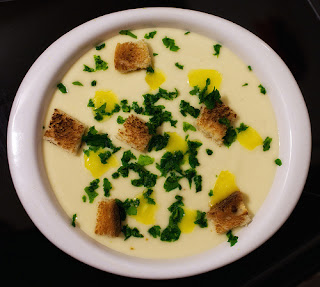from
Behind the French Menu
by
Bryan G. Newman
behindthefrenchmenu@gmail.com
Chervil
Chervil, also called Garden Chervil and French Parsley has a taste that makes you think of very mild parsley and aniseed at the same time; consequently it is very popular in French cuisine. The French love aniseed, but they do not want that taste to be too strong. Chervil’s importance is seen as it is one of the herbs that make up both of France’s favorite herb groups Les Fine Herbes, and Les Herbes de Provence. None of the herbs in the Les Fine Herbes benefit from long cooking; they will be added to a dish just before serving, and that is true for chervil on its own.
Velouté de Chou-Fleur
A velvety cauliflower soup flavored with chervil
Photograph courtesy of Mon Œil
In Les Fine Herbes there are four other herbs: Ciboulette, Chives; Estragon, Tarragon; Persil, Parsley, and Thym, Thyme. In the Herbes de Provence the other herbs besides chervil are Basilic, Basil; Fenouil, Fennel; Estragon, Tarragon; Feuilles de Laurier, Bay Leaves; Marjoram, Oregano; Serpolet or Farigoule, Wild Thyme, and sometimes Sauge, Sage; Sarriette, Summer Savory, and Lavande, Lavender. Chervil apart from special recipes, in a French home, will be simply added to fresh salads where they contrast with stronger salad greens and spicy salad leaves such as rocket. Chervil also adds its flavor to many vinaigrettes.
Fresh or dried chervil?
For French chefs the dried herb is considered practically useless; in fact, I was told more than once when fresh chervil is not available, using parsley and tarragon lightly and in combination is far better than dry and tasteless chervil. N.B. Many packages of the Herbes de Provence sold to tourists contain dried chervil, it will not taste bad, but add fresh chervil when using those herbs if you can. The fresh leaves and stems of chervil are used to flavor soups, casseroles, salads, sauces, eggs and particularly omelets, and chervil is often part of herbal butters.
Chervil
Grow your own
Chervil on French Menus:
Dos de Saint Pierre Grillé Beurre et Cerfeuil – A thick cut from John Dory, the fish, grilled with butter and flavored with chervil. Despite John Dory being a saltwater fish it is traditionally called St Peter’s Fish in many European countries.
Entrecôte Grillée Sauce Béarnaise – A grilled entrecote steak served with a sauce Béarnaise. Sauce Béarnaise is a “child” of Sauce Hollandaise. The chef and restaurateur Jean-Louis Françoise-Collinet, in the 1830’s, made a few changes in Sauce Hollandaise and added Tarragon and Chervil, wine vinegar and shallots. Voila, we have that fantastic sauce, Sauce Béarnaise, While I have seen some modern cookbook recipes for Sauce Béarnaise that omit the chervil when you are in France no self-respecting chef would do that.
A US Filet Mignon, a UK Beef Fillet.
with Sauce Béarnaise
Filet de Bar Cuit Sur Peau, Risotto au Chorizo, Crème de Cerfeuil – Filet of European Sea Bass cooked in its skin, accompanied by a risotto flavored with chorizo sausages and served with a cream of chervil sauce. Chorizo sausages have many tastes, but the most popular will be spicy, that cooled with a cream of chervil sauce will balance very well when served with the Sea Bass.
Gazpacho de Tomates Jaunes, Huile d'Olive Extra Vierge et Cerfeuil – Gazpacho made with yellow tomatoes, extra virgin olive oil, and chervil. When I saw this on a menu, my mouth was watering, I wish that I had been there to taste it. Gazpacho is served chilled, and while tomatoes are the centerpiece of the original recipe, there are many herbs and other vegetables flavoring the dish. Here the soup is served with extra virgin olive oil and chervil; both have characteristics that are destroyed by cooking and so served cold they may make a good cold Gazpacho great. The yellow tomatoes will have only a slight effect on the taste, but they will affect the texture.
Filet De Daurade - Filet of Gilthead Sea Bream
Mousse of Swedes and chervil butter.
Suprême de Poulet Croustillant, Sauce au Cerfeuil – Breast of chicken with a crispy skin served with a chervil flavored sauce.
Sauté de Homard Breton au Cerfeuil – The European two-clawed lobster from Brittany. Here it is lightly fried with the chervil added just before serving. Caveat emptor: France’s considers the lobsters caught off the coast of Brittany to be the very best, and you will pay a great deal more for a European two-clawed lobster than you will for its American cousin caught in Canada or Maine. Check the price carefully.
Tarte Fine d'Asperges Vertes et Blanches, Emulsion de Cerfeuil et Morilles – A delicate tart made with white and green asparagus served with a thick wild morel mushroom sauce flavored with chervil.
When did chervil arrive in France
Gernot Katzer (http://gernot-katzers-spice-pages.com/engl/index.html) attributes chervils arrival in France to Emperor Charlemagne’s edict “Capitulare de Villis” from the 8th-century c.e. That edict included foods and spices to be grown by monasteries and estates owned by the emperor. That edict assuredly aided the herb’s popularity, nevertheless the Romans had been using chervil long before the 8th century c.e. Chervil had originated in the Caucasus and the Romans had no doubt received chervil in trade long before they went and occupied the Caucasus. The Romans occupied France in 121 B.C.E. and then apart from fruits and vegetables and trees like apricots, plums, peaches and cherries they assuredly brought chervil. The Romans also taught the French how to build snail farms and fatten geese for foie gras, their fattened livers. At the same time, they built roads, aqueducts, stadiums, temples, and amphitheaters. You may well ask: What did the Romans ever do for France?
Chervil in the languages of France’s neighbors:
(Catalan – cerfull), (Dutch – kervel), ( German – kerbel. Kerbel, Gartenkerbel, Französische Petersilie ), (Italian – cerfoglio), (Spanish – perifollo).
Connected Posts:
Behind the French Menu
by
Bryan G. Newman
behindthefrenchmenu@gmail.com
Copyright 2010, 2016.















